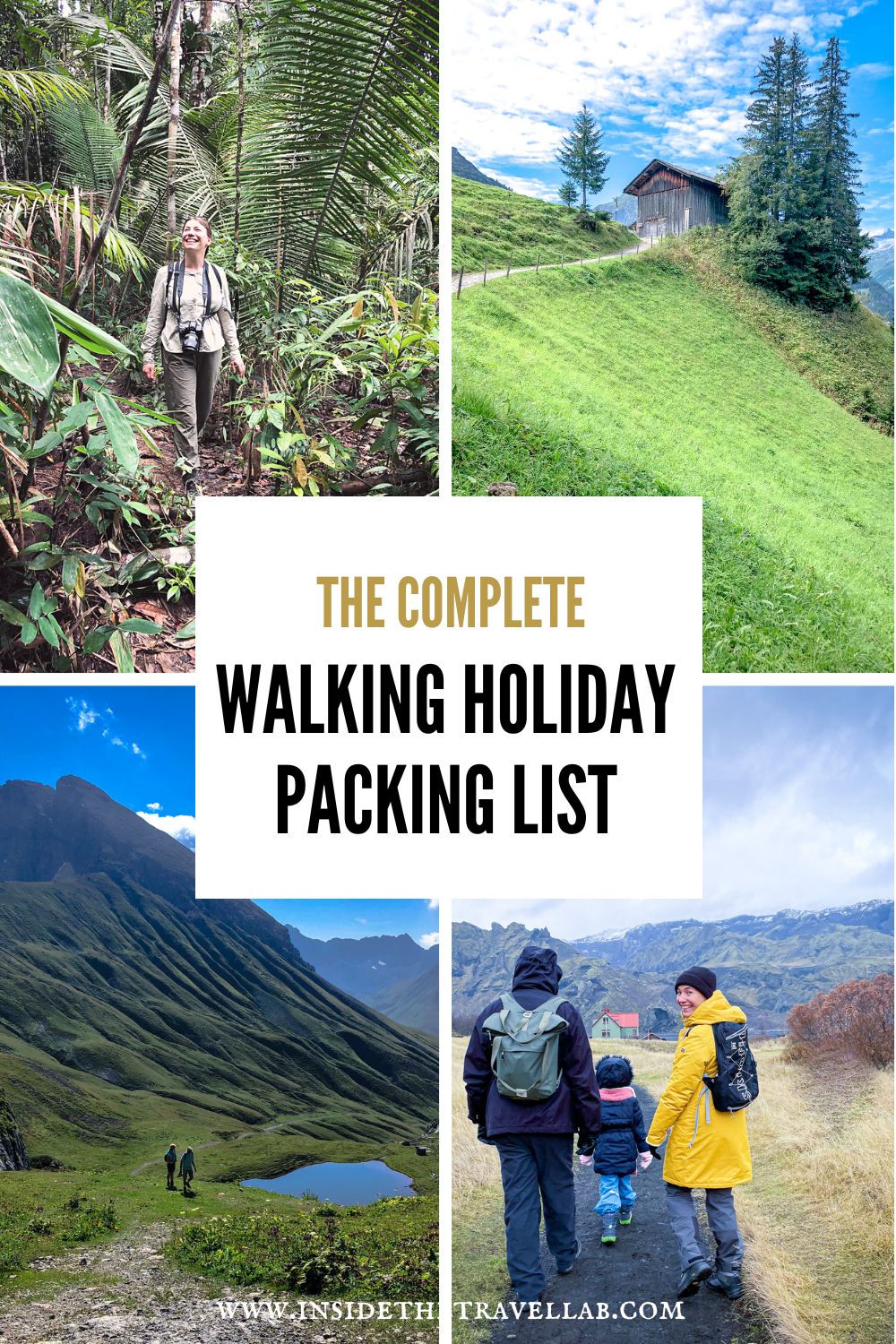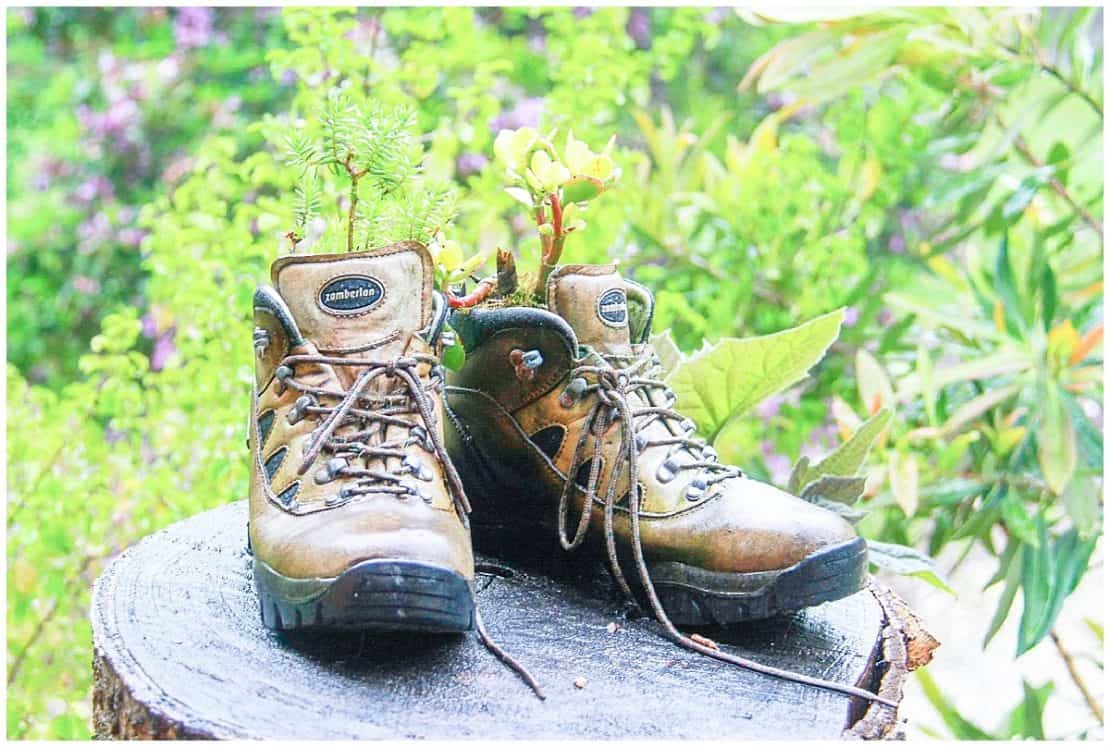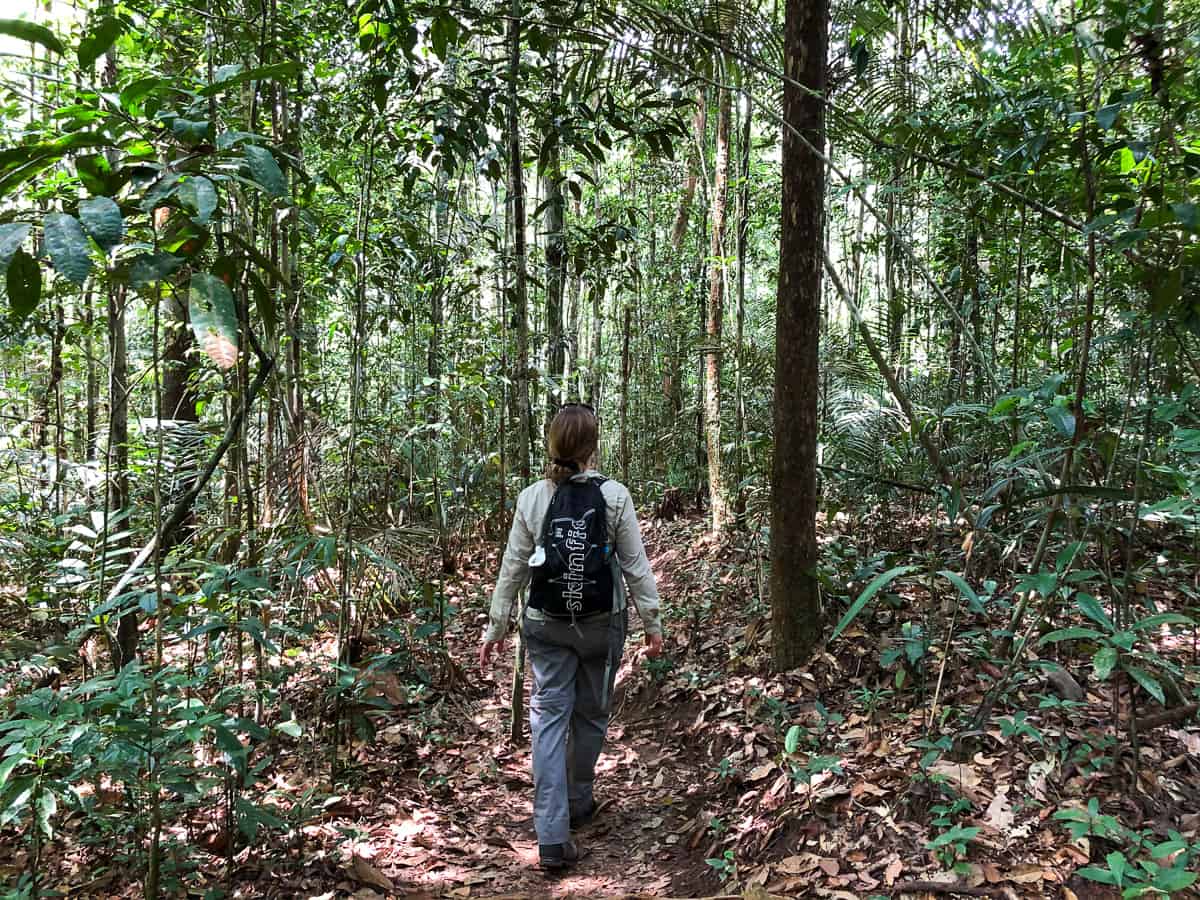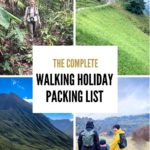Wondering what to pack for a walking holiday? Download our free walking holiday packing list as a PDF, gather together your trekking essentials, get packing and have a great trip!
You may also be interested in this gift guide for hikers.

Your Hiking Trip Packing List
Some things always stay the same. If you have the right gear, you have a better time.
From the glamour of Italy’s Amalfi Coast to the high altitude cloud forests of Ecuador and Peru, whether you’re hiking, walking, trekking or whatever you want to call it, you’ll be far more comfortable if you have the right kit.
So that’s what we’ve gathered together in this walking holiday packing list.
If you buy through some of these links, I may earn a small commission at no extra cost to you. But as someone who has hiked many a mountain around the world, there’s no way I’m going to recommend anything that I wouldn’t use myself!
How to Use This Hiking Trip Checklist
I’ve arranged this walking holiday packing list in terms of importance. So, items at the top are true hiking gear essentials, while the further on you go, the more optional the suggestions become.
And, of course, don’t forget that you can download a handy copy of the walking holiday checklist right here for free.
Your walking holiday shopping list
You can find most of these items in one easy place on my hiking list Amazon page here. Otherwise, I have highlighted specific trekking trip essentials below.
Walking Holiday Packing List Essentials
In order of importance…

1) Comfortable Walking Boots
It may sound obvious, but finding comfortable walking boots is THE THING to get right. Much as you can’t have a circus without a clown so you can’t have a decent walking holiday without the right walking shoes.
Top tips for buying walking boots
- Wear thick socks and err on the side of slightly too loose rather than slightly too tight. Your feet get hot when you walk (even in cold climates) and hot feet means swollen feet, which means you need slightly more room in your shoes.
- Waterproof, breathable fabrics are all good things to hear. So is Gore-Tex. A grip on the soles is a must.
- Wear your walking socks when trying on the shoes.
- Decent walking boots need a wash and a chemical spray from time to time so buy that with the boots.
- It’s vital to wear in your hiking boots before your walking holiday. Start by wearing them around the house and then gradually increase the amount of walking so that you can ease into them and them into you.
- What to look for?
- When shopping for walking boots or hiking shoes, look for ankle support. That means, opting for boots that rise to cover your ankles.
- If you’ve left it all too late (and no-one’s judging here) then trainers, sneakers or trail running shoes will likely carry you through.
- But as you walk over uneven ground, your ankles bend and twist, as they’re supposed to. Ankle support from your footwear will stop things bending too far and will save you from sprains and strains.
Open Sandals or Closed Walking Boots?
If you’re going to be walking through tropical areas then closed, sensible boots are crucial. They help protect from snake bites, mosquito bites and contamination. It’s pretty easy for water from infected sources (including sewage) to come into contact with any cuts on your feet if you wear sandals. I used to wear non-sexy but practical Teva sandals in such situations but after finishing medical school, it’s closed toe boots all the way.
2) A way to carry water
Once you’re walking for more than an hour, you’re going to need some water (and if you’re walking through extreme conditions, you’re going to need it sooner than that.)
At one end of the spectrum, you can have a plastic water bottle slung into a sexy leather handbag. At other ends, you’re going to need more.
Depending on your route, you may benefit from one of these metal reusable water bottles with a carabiner you can clip to your bag.
Alternatively, I love the Platypus water systems if you want to keep your hands free (they’re a pouch that fits into a rucksack with a long plastic tube you can clip on to the front strap.
You can drink from the tube as and when you need to without having to stop and take the rucksack off and rummage around.) Most of the time, that will do. If you go anywhere where you need to filter and purify water yourself, then consider a full water purification kit.
So, in short, you need a water bottle or pouch and a bag to carry it in.
Check Water Bottle and Pack Prices Here
- Check the latest prices for the Platypus water system here.
- Check this mini water purification kit here.
3) Sunscreen
Yes, wherever you are these days, you still need sunscreen. We’re all supposed to be wearing factor 15 SPF even in the midst of foggy grey Britain so if you’re planning on being outside for more than an hour you’ll definitely need this.
Check out travel size sunscreens to keep your daypack lighter, only bring lip balm if you really think you need it and look for clear sprays to cut down on the gloop and mess factor.
Recommended water resistant sunscreen
This water resistant sunscreen has zinc and a hefty SPF 50, which should leave you covered (sorry, couldn’t resist.) Buy the sunscreen here.
4) A Map Holder
I almost put this in the nicety section. Almost. But instead, I opted for including it here just to prompt you to think of the weather. Is it going to rain? Snow? Shower you with sand in a dust storm? If so, then you need something to protect your map, whether you’re using a paper map or a smartphone version.
Why? Because if you can’t read your map, you may as well not have it. (And bear in mind that if you’re betting on using your phone you may want to think about back up power supplies and mobile phone reception away from cities.)
From painful experience, I now always carry something to protect my map. You can stay simple with a zip-lock plastic bag from a supermarket or jazz things up with a purpose-built device from camping shops, complete with a waterproof zip and lanyard.
But whatever you do, think about this before you set off.
Recommended map holders for paper and phones
Check the latest price on this large map holder with lanyard here.
5) Blister Protection
No matter how well you break in your boots, in my experience, a blister will blight its way into your life one way or another. So a quick bit of first aid – leave the things alone! If you must “pierce” them, do so with a sterile needle and cover with a sterile dressing. Don’t have those things? Not sure what sterile means beyond you can’t have children? Leave well alone.
Instead, cover the injured area with a well-heated compeed (I pack these in every bag for every assignment.) Failing that, a plaster (band-aid) will do.
Compeed: the best blister protection
You can pick up Compeed at most pharmacists and airport shops but if you want to be prepared, you can also buy compeed here.
6) Bug Spray
Weeeeeellllll. I guess it’s not 100% essential, unless you’re travelling through an area plagued with malaria, dengue, sleeping sickness or what have you.
But even if the bites don’t kill you, let’s face it, they’re extremely annoying. And they tend to come out whenever you stray from the cities.
So, sling a travel-sized bug spray into your bag and you’ll be set.
Recommended Bug Spray
Again, you should be able to find all kinds of insect repellent at pharmacists or at the airport. But if you want to leave the house with all your hiking trip essentials, you can order some bug spray here.
7) A Hat
Yes, I know. Unless you’re a cowboy, hats aren’t cool. I spent years, YEARS I tell you, thinking that I was OK in hot weather without a hat yet strangely ending up with headaches, nausea and feeling faint. At some point after the mighty 3-0 I started wearing a hat. Outdoors. Almost all the time. Sartorially, the result may have been a failure. In every other respect it was a success.
Wear hats kids. It’s that easy. I use a cool packable, sackable, crushable one. Much easier to haul around than a fixed one.
Buy Your Cool Folding Travel Hat Here
- Find an instagrammable wide-brimmed straw hat here.
- And a folding, practical walking hat for women here.
- Here’s a compressible travel hat with neck protection for anyone with short hair.
8) Snacks
Anyone with a young family will know the importance of the snack.
Folk, we need energy. Probably not while we’re sat at our desks day in, day out, but when we’re out on the open road, we do. Pack something that will feed you well (unless the place you’re going to will take care of that.)
Complex carbs are the key (like trail mix – hey, there’s a reason they gave it that name!) so look for some kind of combo of oats, seeds and dried fruit. Chocolate and sugar based sweets (like Kendall mint cake) are OK too but they are likely to give you energy in one big rush and then leave you a little drained.
9) Sanitary and hygiene products (Yes, men too!)
No, guys, I don’t mean tampons. (Though girls, just as an aide memoire on the hiking gear checklist… )
If you’re going to be walking for some time, away from the city, you’re going to need to go to the loo/washroom/bathroom/restroom etc.
In the wild.
Alone.
Exposed.
That means, you’ll need toilet paper. And something to wash your hands with afterwards. Depending on the environment you’re in, you may need something (a plastic bag) to carry away your paper in.
So: tissues, hand wipes/sanitizer, plastic bags should all go on your gear list.
Enough said.
(And depending on circumstance, the bug spray can become crucial here too.)
Buy Your Sanitary Gear
I’m presuming you already know where to find this…
10) Protective Clothes
Yes! That’s right! We want you to ride out into the wilderness looking like a knight in shining 21st century armour!
If you’re walking for a considerable time, then you’re likely to be out in nature. If you’re out in nature for any period of time then you’re likely to be around things that scratch and things that bite.
Long sleeves, more importantly, long trousers protect against this.
If you’re walking somewhere where the air is cool then clearly this won’t be a problem. If your’e walking somewhere hot, you’ll need to give this more thought.
Do you want to opt for long cotton trousers? (Look elegant, snag more easily, keep you cool.) Or zip off trousers in quick-dry fabrics (fashion folk will mock you but your skin and outerwear will stay in one piece. Plus you’re protected from insect bites. )
The choice is yours…
Recommended trekking clothes for your hiking checklist
- The best hiking pants or trousers are lightweight, long and with plenty of pockets. Like these hiking trousers here.
- For tops, you can stick to T shirts most of the time unless you are walking through somewhere hot and need to protect against bites.
- The best jacket for a walking holiday should also be lightweight and waterproof, like this rain jacket here.
Check out the article on what to wear in the Amazon and the best jungle clothes for more details.

Even though it’s hot, wear long sleeves and full length trousers as your jungle clothing
11) Day Packs
When it come to day packs for hiking, walking or trekking, I could talk for hours. Finding a lightweight, comfy fit makes such a difference.
My absolutely favourite backpack came from Skinfit and you can see it in the photo above!
It’s a European brand but never fear, I have tested plenty and have some recommendations to make.
For this day hiking checklist, I’m assuming that you’re not actually backpacking and carrying all your luggage. I’m assuming you’ll either go on a hike and return to base or that you’re on a walking holiday where someone will transport your main luggage to your next accommodation.
So, with that in mind, a good day pack for hikers should have the following features:
- Be a backpack rather than a cross body bag.
- Be very lightweight
- Have a good system for carrying water (either a Platypus system or pocket for a water bottle at the side.)
- Have a hip belt and possible chest strap.
- Have adjustable straps.
- Be waterproof or water resistant.
With the following bonus features:
- A roll-down waterproof covering for heavy downpours.
- A small zipped pocket for keys and valuables.
- A padded, removable section for sitting on.
- At least two main sections for wet and dry clothes, sanitary and, well, less sanitary items.
Where to buy a hiking day pack
- The best option by miles as far as I’m concerned is this Aurora backpack from Skinfit. Male and female colleagues have tested it and all agree!
- That said, if you’re looking for more options, check out this article on hiking backpacks for women.
Fun Things to Pack for Your Hiking Trip or Walking Holiday
1) Proper Walking Socks
I’ll admit, I was sceptical. Socks. SOCKS?!!!!! James Bond never wore socks! Oh, wait…
Then I tried some out. First skiing. Then walking.
And…well…cough…splutter…yes, I do think they’re worth it.
Decent walking socks come equipped for the weather you’re walking in, with reinforced patches at the heel and toe and vents to help cool your feet.
They’re pricy compared to your average sock. But, if you can, I’d say go for it.
PS – socks have different temperature gradings for different environments. Make sure you’re feet are snuggled up into the right ones. Merino wool is what you need to look for.
2) Camera
I’ve put this here because I realise not everyone shares the same obsession as me when it comes to photography. For me, a camera would be up there in the top as an essential. You’ve got to capture those amazing views!
Regardless of your feelings on the subject, the important thing here refers to how you carry it.
Do you…
- have a waterproof cover in case it rains/snows/becomes too humid?
- have you thought about spare batteries/memory cards?
- do you have a way of carrying any spare lenses?
I’ve tested and paid for a lot of expensive options. But ultimately, I’ve not found anything better than a large zip lock plastic bag for this.
3) Torch
For most hiking trips and walking holidays, you won’t need a torch. But if you plan on camping or if you know you’ll be cutting it fine to reach base before sundown or if you plan on exploring caves or joining extreme tours then a torch is a must. Pack extra batteries if you’re going on an a series of day hikes through somewhere very cold as batteries drain faster then.
Where to buy a hiking Torch
I’d always recommend a hands-free head torch for any kind of trekking, like this one here.
4) Whistle
Something left over from my Brownie Guide days. Useful for calling for help if you’re injured and don’t have phone reception.
Where to buy a Whistle
These bright whistles in emergency colours with lanyards work well for remote situations.
5) Walking Poles
If you’re walking on steep, slippery, moss covered rocks then walking poles or trekking poles can help you out. For flat, dry paths, don’t bother: they’ll just become kit to weigh you down.
Where to buy Walking Poles
You can find adjustable trekking poles in a range of colours here.
6) Adventure Medical Kits
It’s always a good idea to bring a basic first aid kit with you. First aid essentials include bandages, plasters, scissors, tweezers or forceps and an antibacterial wipe. A silver, reflective emergency foil blanket can also be handy.
It’s also always a good idea to bring spare contact lenses and extra doses of any medication you normally take.
Where to buy a Medical Kit
For longer expeditions, you’ll need a more in depth medical kit. But for most walking holidays and hiking trips, a mid-range medical kit like this will be absolutely fine.
7) Sleeping Bags and Camping Gear
If you’re not only hiking but camping outside as well, then you’ll need a whole lot of extra backpacking gear from ground sheets to repair kits and more.
Yet sometimes, if you’re sleeping overnight in mountain refuge hut, a sleeping bag will do as everything else will be provided.
In that case, I’d recommend a washable sleeping bag liner and a sleeping bag appropriate to the temperature you need (they’re made of different thicknesses so read the label before you buy!) If your sleeping bag doesn’t come with one, it’s worth investing in a sleeping bag compression system as well to save space in your rucksack.
Where to buy a Sleeping Bag
Check prices on mid-range sleeping bags with compression systems here.
FAQS about what to pack for a walking holiday
How do I prepare for a walking holiday?
First of all, download this walking holiday packing list and start making sure you have all the gear you need! Wear in your walking boots and socks, first around the house and then on local trails if they are new to you. Build up your fitness so that you can enjoy your hiking holiday when you get there!
What should I pack for a walking holiday?
This article walks you (sorry!) through the hiking essentials you need when you’re heading out to trek your way around the world on a hiking holiday. It works just as well for North America as South Africa, New Zealand and Europe.
Download your hiking packing checklist PDF here
Don’t forget, you can download your complete walking holiday packing list here.
More Travel Tips for Hiking Trips and Walking Holidays
- The jungle clothing you need to hike through the Amazon
- The ultimate travel packing checklist with printable PDF


Glad to be of service! Have a great time in Egypt – fascinating country.